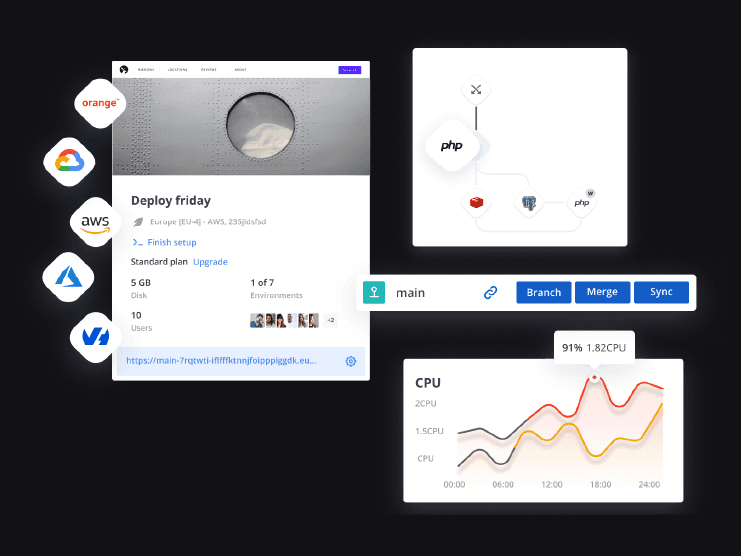Building applications and managing infrastructure at the same time is a complex task. It involves managing multiple software and hardware components, plus an evolving ecosystem of dependencies and external tools. There’s also the need to keep up with changing technologies while coordinating different teams and delivering solutions to meet business goals.
Is there a solution to manage it all?
To address these many challenges, organizations are turning to cloud-based ready-to-use platforms for efficient and cost-effective application development and management— the Platform as a Service, or PaaS. Platform.sh is a PaaS that allows developers to efficiently build, iterate, and deploy applications with their current, Git-based workflows and tech stacks—all while the platform seamlessly manages cloud infrastructure, data services, and security, behind-the-scenes.
Basically, Platform.sh removes the complexities of WebOps cloud infrastructure management and optimizes development-to-production workflows, so developers can focus on delivering applications faster. Additionally, unlike time-intensive, build-it-yourself approaches, Platform.sh offers an efficient, reliable, and secure alternative, with the following benefits:
Automated infrastructure
Thanks to automated cloud infrastructure, including provisioning and fully integrated CI/CD pipelines, developers can quickly and autonomously build and deploy new environments, so tech teams can deliver products on shorter timelines.
Reliability, scalability, and security
Our infrastructure has an up-to 99.99% SLA and a 24x7, globally distributed, enterprise support team that actively monitors and handles issues as they occur, so you always stay informed. Daily automated backups also secure your environments, websites, and applications, ensuring all projects stay safe and intact. And for the busiest times, flexible infrastructure automatically and efficiently scales to accommodate traffic surges. Plus, automated updates help tech teams manage security and compliance so developers can focus on building code.
Platform flexibility
Platform.sh adapts to developers, not the other way around. Gain the freedom to develop applications in every major programming language, framework, and stack thanks to seamless integration with the tools your developers use. There’s no risk of lock-in— work with the tools and tech you’ve already invested in. Additionally, development teams are free to experiment and innovate across 14 languages, and an array of built-in services from one platform.
Sustainability
By providing relevant insights through code profiling, application performance monitoring (APM), framework recommendations, and detailed infrastructure metrics, you can optimize code and application performance, enabling your business to reduce carbon emissions by up to 15x. You can also choose your data center region, giving you the option to select the greenest possible area when deploying new projects.
A state-of-the-art-PaaS gives organizations the ability to focus on innovation and growth, giving them an advantage in today’s lightning-quick digital market. And for developers, there’s the advantage of bringing your existing code onto a solution that doesn’t lock you in or force you to adapt. You can take your code and execute it immediately, without rebuilding the application to fit unfamiliar technology.
13 components of a state-of-the-art PaaS
Let’s check out the 13 must-have components that a PaaS provider like Platform.sh offers. Here’s everything your team can use to build and deliver your applications faster and keep up with, or ahead of, the competition:
1. Instant provisioning
With Platform.sh, provisioning can happen easily and quickly, allowing developers to focus on application development and testing rather than allocating and configuring the resources required for running applications. PaaS platforms can also provide pre-built templates and configurations for popular development frameworks, which can simplify the provisioning process even further.
2. Embedded IaC
Developers can use IaC to create, manage, and modify infrastructure with a few lines of simple code. By using a PaaS that offers an easy IaC setup, developers can create and deploy applications faster and more reliably, while reducing the risk of error and ensuring that infrastructure is always consistent and up-to-date.
3. Seamless packaging
Reliability requires consistent packaging, and for a PaaS that requirement has to be simple. So simple that what’s packaged shouldn’t require external tools and additional configuration to implement in a repeatable, reliable way. Everything you need to build an application should already exist in a Git repository from the beginning, enabling developers to test and validate applications before they’re deployed automatically, reducing complexity and saving time.
4. Automated CI/CD pipeline
Platform.sh automates many of the processes involved in building and deploying an application. It includes provisioning the necessary resources, checking and applying configurations and dependencies, running builds, managing containers and deploying with reliability and maximum availability. Environments should be on-demand, and as close to production as possible at all times. That way, pushing to production is encouraged, frictionless and anxiety-free, every time.
5. Integrated testing
Our platform provides developers with pre-built, easy-to-configure environments for various stages of the testing process, in addition to the tools that can help developers identify and fix errors in their applications before deployment. With byte-level copies of your staging environments, cloned from production for every new feature and fix, nothing has to differ from staging to production—meaning no surprises. And you can simplify the overall testing process through the entire lifecycle of a project thanks to our integration of reliable tools and resources, like Blackfire observability, that test and monitor application performance at scale.
6. Easy data management
Data management is easier with a PaaS thanks to pre-configured databases and data storage solutions. This simplifies the process of setting up your services, and eliminates the need to develop expertise outside of your applications to manage them and keep them secure. PaaS platforms like Platform.sh provide data analytics and processing tools, too, which can help decipher lots of data at once and uncover insights that can help improve applications. PaaS platforms also typically offer data backup and recovery features, so data stays available in case of system failures or other issues.
7. Observability and monitoring
PaaS offerings can enable seamless monitoring of network traffic, server-side logs, metrics, alerts, traces, and many other measurements, through all-in-one dashboards and tools that make it easier to extract insights into system behavior, performance, and health. Observability on a PaaS can also help identify and isolate performance bottlenecks in the code or inefficient uses of infrastructure. This under-one-roof approach removes the burden of managing several different monitoring and observability products, reducing the complexity of operations and ensuring the reliability and availability of deployed applications.
8. Auto-scaling capabilities
Auto-scaling features can quickly adjust resources to meet high-impact scenarios, such as traffic surges, and send alerts when certain thresholds are met. Anytime a site or application approaches a resource consumption threshold, systems can automatically double the amount of those resources for production environments in minutes. This makes it much easier for development teams to manage and monitor their applications’ health, and give them the confidence that their products are operating efficiently and effectively.
9. Streamlined operations
The complexity of handling the underlying infrastructure, including scaling, backups, and updates, can be reduced so DevOps teams can focus on developing and delivering the application itself. Our PaaS takes care of the operations and infrastructure-level maintenance, and provides cloned staging environments where you can test updated apps without any risks or security concerns. Each environment exists in isolation, allowing multiple lines of work to move in parallel without disrupting other features, or production.
10. Robust security
Using our PaaS solution can help ensure that applications and their data stay secure from the outset via encryption of data in transit and at rest to protect personally identifiable information such as passwords, credit card data, or any other sensitive information. A WAF (web application firewall) helps to protect applications from security threats such as header injection and request smuggling, while anti-DDOS protection prevents extended downtime from malicious attacks. Not only does data stay safe, but your code is guarded as well. Read-only runtime containers ensure that production cannot be changed, and SSH access is only granted by explicit permission on your end.
11. Essential compliance
Using our PaaS solution can help ensure that applications and their data stay secure from the outset via encryption of data in transit and at rest to protect personally identifiable information such as passwords, credit card data, or any other sensitive information. A WAF (web application firewall) helps to protect applications from security threats such as header injection and request smuggling, while anti-DDOS protection prevents extended downtime from malicious attacks. Not only does data stay safe, but your code is guarded as well. Read-only runtime containers ensure that production cannot be changed, and SSH access is only granted by explicit permission on your end.
12. Managed access control
Role-based permissions to access data, and identity management for the entire organization, can help minimize the risk of unauthorized access and prevent data breaches. Platform.sh achieves this by providing keyless SSH mechanisms that automatically injects SSH keys into virtual machines, reducing the risk of key mismanagement, alongside MFA which bolsters the authentication process to prevent unauthorized access. There’s also SSO, which reduces the need to manage multiple credentials. With these controls, businesses can better manage user identities, credentials, and access privileges, allowing for greater governance over code and customer data. They can also control access to APIs, providing audit trails so organizations can keep track of all user activity, which is necessary for compliance.
13. Sustainability
Lastly, organizations with green initiatives will find a lot to like in Platform.sh, including efficient infrastructure that helps reduce energy consumption and minimizes their carbon footprint by optimizing resource usage. How? Through automatic resource allocation, which increases or decreases resource consumption based on necessity, allowing businesses to minimize waste and improve operational efficiency. By leveraging Platform.sh’s PaaS, companies can take advantage of multiple green features, so they can reduce their overall environmental impact and achieve their sustainability goals.
Test it out yourself for free
Time to put our words into action and test out our PaaS for yourself with our free trial. Discover how building and deploying your applications faster can be so much easier than you thought.
 Switching to Platform.sh can help IT/DevOps organizations drive 219% ROI
Switching to Platform.sh can help IT/DevOps organizations drive 219% ROI Organizations, the ultimate way to manage your users and projects
Organizations, the ultimate way to manage your users and projects





